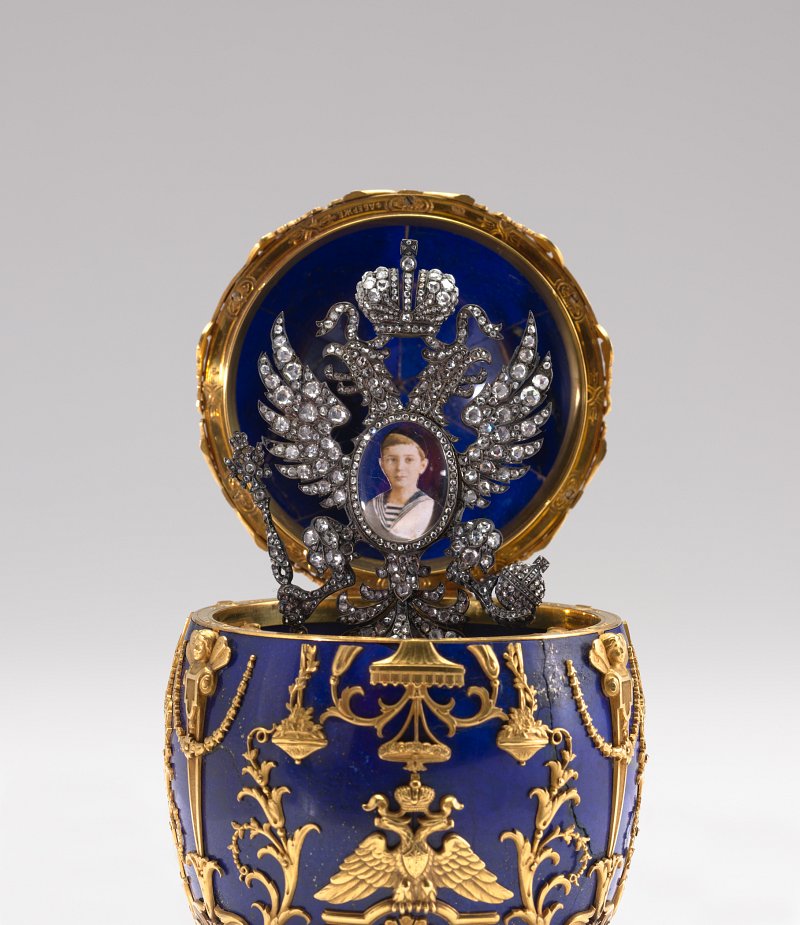
Imperial Tsesarevich Easter Egg (detail), 1912. Virginia Museum of Fine Arts, Richmond. Bequest of Lillian Thomas Pratt. Photo by Katherine Wetzel. © Virginia Museum of Fine Arts.
Fabergé Revealed
Peabody Essex Museum in Salem, Massachusetts
On view June 22, 2013 to September 29, 2013
More than 230 rare and storied treasures created by the House of Fabergé, between 1855 and 1916, are celebrated in a new exhibition at the Peabody Essex Museum (PEM), Fabergé Revealed. Imperial eggs, ruby-encrusted brooches, gold and diamond cigarette cases, enameled parasol handles and carved stone animals display the diverse and exquisite designs of Peter Carl Fabergé’s craftsmen. Fabergé Revealed is drawn from the Collection of the Virginia Museum of Fine Arts and will be on view at PEM from June 22 until September 29, 2013.
The name Fabergé is as inextricably linked to luxury as it is to intrigue, due to the loss of iconic works when the Romanov regime was toppled during the Russian Revolution. This year marks the 400th anniversary of the founding of the Romanov dynasty, whose fall scattered a priceless cache of Fabergé eggs, jewelry and precious objects into the hands of the world’s most powerful families. From Queen Victoria, who used a red-and-white Fabergé notebook, to the royal family of Monaco who possess one of the oldest imperial eggs and America’s Forbes family who sold the largest collection of imperial eggs to a Russian oil tycoon. Fabergé’s creations have become larger than life in the popular imagination, symbolizing imperial decadence as much as the fate of millions of Russians struggling to feed themselves in the early 20th century.
“The legacy of Fabergé is one that has continually captivated the public imagination,” says Dean Lahikainen, PEM’s Carolyn and Peter Lynch Curator of American Decorative Art. “Equally compelling are the concurrent histories of these exquisite objects and the people who possessed them.”
Designed for Russian tsars to bestow as Easter gifts on their loved ones, Fabergé’s iconic imperial eggs –– of which there are only 42 still known to exist –– are sublimely intricate creations laced with precious metals and jewels. The Imperial Tsesarevich Easter Egg of 1912, on view at PEM, was a gift to Empress Alexandra from her husband, Emperor Nicholas II. The egg commemorates their son Alexei who nearly died the previous year of hemophilia. For the shell, craftsmen joined six wedges of highly-prized lapis lazuli and hid the seams with an elaborate gold filigree encasement. Inside the egg, a diamond encrusted Romanov family crest frames a two-sided portrait of the young child.
To understand why these objects were associated with refinement and luxury, one has only to examine the relentless pursuit of perfection and the savvy business strategies of the House of Fabergé. Beyond the elegant showrooms in Moscow and Saint Petersburg, hundreds of the country’s finest goldsmiths, enamellers, stone carvers, gem cutters and jewelers were at work creating innovative and complex designs that could not be readily imitated. In the hands of Fabergé craftsmen, even the most familiar objects were given the highest level of aesthetic consideration and no expense, material or man hour was spared. When commemorating a royal occasion, nothing but a Fabergé trinket, bonbonnière or enameled cigarette case would do, thereby making the wealthy and powerful ambassadors of the Fabergé label.
The presence of the Romanov family –– Emperor Nicholas II, Empress Alexandra and their five children –– is most intimately felt in the exhibition through the display of more than 40 family photographs held in enameled Fabergé frames. These family photographs and jewels were some of the only possessions the Romanovs took with them when they were forced out of St. Petersburg during the Revolution. In an effort to preserve their wealth, the Romanov daughters are said to have sewn Fabergé jewels into their undergarments. In the end, their diamond-lined corsets managed to prolong their execution and sealed the fate for the inevitable fall of the dynasty.
EXHIBITION CREDITS This presentation of Fabergé Revealed has been organized with the Virginia Museum of Fine Arts and the Detroit Institute of Arts. Support provided by the East India Marine Associates of the Peabody Essex Museum. Additional support provided by Eaton Vance Investment Counsel.
EXHIBITION DETAILS A ticketed $5 exhibition admission charge includes an audio guide tour of the exhibition. An exhibition catalog, Faberge Revealed, is available for sale in the Museum Shop.
PRESS PREVIEW TUESDAY, JUNE 18, 2013 | 9:30 AM BREAKFAST | 10 AM REMARKS | 10:30 AM TOUR Please join us for a breakfast and exhibition preview tour with Curator Dean Lahikainen. RSVP to Dinah Cardin by Tuesday, June 11, by emailing dinah_cardin@pem.org or calling 978-745-9500, ext. 3230.
PUBLIC PROGRAMS SATURDAY, JUNE 22 | 10 am–4:30 pm Opening Day Festival | Included with museum admission | Made possible by the Lowell Institute
Mysterious and elegant, compelling and intricate, the works of the House of Fabergé hold an enduring fascination. Join us for a daylong exploration of a master craftsman and his royal clients. Talks, demonstrations and a film offer an up-close view of the craftsmanship, materials, cultural influences and remarkable history of some of the world’s most iconic objects of luxury.